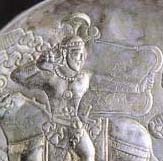The Epic Of Gilgamesh - written by a Middle Eastern scholar 2,500 years before the birth of Christ - commemorated the life of the ruler of the city of Uruk, from which Iraq gets its name.
Now, a German-led expedition has discovered what is thought to be the entire city of Uruk - including, where the Euphrates once flowed, the last resting place of its famous King.
'I don't want to say definitely it was the grave of King Gilgamesh, but it looks very similar to that described in the epic,' Jorg Fassbinder, of the Bavarian department of Historical Monuments in Munich.
Gilgamesh was described as having been buried under the Euphrates, in a tomb apparently constructed when the waters of the ancient river parted following his death.
"We found just outside the city an area in the middle of the former Euphrates river? the remains of such a building which could be interpreted as a burial," Mr Fassbinder said.
We have found garden structures and field structures as described in the epic, and we found Babylonian houses."
But he said the most astonishing find was an incredibly sophisticated system of canals.
"Very clearly, we can see in the canals some structures showing that flooding destroyed some houses, which means it was a highly developed system."




